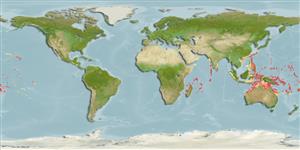Actinopterygii (ray-finned fishes) >
Perciformes (Perch-likes) >
Labridae (Wrasses)
Etymology: Labropsis: Greek, labrax, -akos = a fish, Dicentrarchus labrax + Greek,opsis = appearance (Ref. 45335). More on author: Randall.
Environment / Climate / Range
Ecology
Marine; reef-associated; depth range 7 - 55 m (Ref. 2334), usually 7 - 55 m (Ref. 27115). Tropical; 24°C - 27°C (Ref. 27115), preferred ?; 33°N - 24°S
Indo-Pacific: East Africa to Samoa, north to Izu Islands, south to the Great Barrier Reef.
Size / Weight / Age
Maturity: Lm ? range ? - ? cm
Max length : 13.0 cm TL male/unsexed; (Ref. 2334)
Dorsal
spines
(total): 9;
Dorsal
soft rays
(total): 11;
Anal
spines: 3;
Anal
soft rays: 10. Scales on lateral line: 46-49 (+2 past hypural) (Ref. 1602). Juveniles are black with several white pinstripes; females become lighter dorsally, and males develop golden centered scales, blue lines on the face, and a wedge-shaped white area in the center of the tail (Ref. 1602).
Uncommon inhabitant of coral-rich areas of clear outer lagoon and seaward reefs (Ref. 1602). May form small groups (Ref. 90102). Males generally solitary (Ref. 9710). Juveniles are cleaners while adults feed on coral polyps (Ref. 1602).
Life cycle and mating behavior
Maturity | Reproduction | Spawning | Eggs | Fecundity | Larvae
Oviparous, distinct pairing during breeding (Ref. 205).
Randall, J.E., G.R. Allen and R.C. Steene, 1990. Fishes of the Great Barrier Reef and Coral Sea. University of Hawaii Press, Honolulu, Hawaii. 506 p. (Ref. 2334)
IUCN Red List Status (Ref. 115185)
CITES (Ref. 94142)
Not Evaluated
Threat to humans
Harmless
Human uses
Aquarium: commercial
More information
ReferencesAquacultureAquaculture profileStrainsGeneticsAllele frequenciesHeritabilityDiseasesProcessingMass conversion
Tools
Special reports
Download XML
Internet sources
